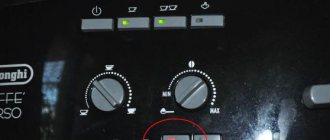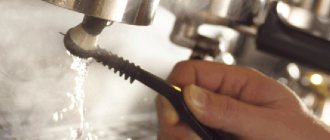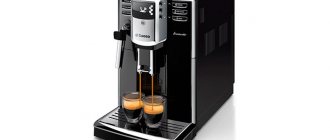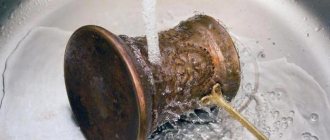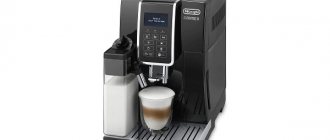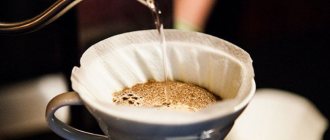Tatyana Noticed pieces of scale in the coffee
I love coffee, especially in the morning. I finally decided to buy a good coffee maker. I looked closely for a long time, bought it six months ago on sale at half price. Now I notice that she is starting to slow down. The coffee takes longer to brew and sometimes there are pieces of scale floating in the coffee. And I haven’t cleaned the device once in six months. Now I want to figure out how to descale a coffee maker at home, let’s do it together.
The coffee maker should be descaled once every 2-3 months, otherwise scale deposits may get into the coffee and cause harm to health.
Causes of scale
The cause of limescale is the hardness salts CaCO3 and MgCO3 (salts of rare earth metals calcium and magnesium) that are poorly soluble in water. These compounds are formed by heating bicarbonates Ca(HCO3)2 and Mg(HCO3)2, which are part of natural water and decompose at temperatures above +40 ºС.
Ca(HCO3)2 = CaCO3 + H2O + CO2;
Mg(HCO3)2 = MgCO3 + H2O + CO2.
If you install an ion exchange filter or a device that magnetizes water on the incoming water pipe, you can significantly reduce the deposition of hardness salts on heaters and extend the service life of not only the coffee maker, but also the boiler, kettle, washing machine and dishwasher.
Signs of a clogged coffee maker
When using water containing hardness salts, scale will inevitably form in the coffee maker. Both simple drip and capsule or carob coffee makers are susceptible to clogging.
The more bends and smaller the diameter of the tubes for the passage of water in the coffee maker, the greater the likelihood of scale formation. Lime scale particles clog water flow channels.
Not all coffee makers are equipped with a built-in indicator (a counter for the number of cups of coffee brewed), so you need to be able to recognize signs of limescale deposits inside the machine:
- It takes longer to prepare one serving of drink than before;
- if the tube and outlet are clogged, the stream of ready-made coffee becomes thin, causing the cup to take longer to fill;
- the taste of the drink has deteriorated;
- there is a foreign smell;
- the operating device began to make unusual sounds;
- a light gray sediment is visible in the cup;
- Electricity consumption has increased while the coffee maker is operating.
According to repair specialists, boiler-type capsule and carob coffee makers are most susceptible to heater overgrowth and tube clogging. In devices with a thermoblock, water does not stagnate, and the process of scale formation proceeds more slowly.
If limescale deposits have appeared, you need to get rid of it, and descaling the coffee maker is also possible at home.
In very advanced cases, the coffee maker will have to be disassembled
Remember
I learned how to descale a coffee maker and that it needs to be done regularly. There are many means for this.
Remember a few more tips:
- Choose the right cleaning product. There are many liquids and powders available for descaling. Buy products that are suitable for coffee makers.
- Do not clean with abrasives. Soda and bleach will damage the parts of the coffee machine. I also don’t recommend cleaning internal surfaces with soap - the coffee will give off a soapy taste.
- Clean regularly. You need to clean your car once every 2 months, otherwise scale deposits will be more difficult to deal with. For example, at home it is good to clean the coffee maker with citric acid.
Video: descaling a coffee machine
Professional and folk remedies for cleaning coffee makers
Coffee machine manufacturers have long created a separate source of income for themselves: they produce and sell products for descaling devices. The latest generation models have an auto-cleaning function with the obligatory use of a proprietary product. After brewing 200-300 cups of coffee, the smart unit signals that it's time to clean. Professional products are produced in the form of tablets, powders and liquids.
Each coffee machine manufacturer claims that only branded products can be used. This is nothing more than a marketing ploy. If you read the ingredients on the label, it becomes clear that the main component is citric acid. Is it worth spending a lot of money (from 1000 to 1200 rubles) on purchasing a branded product when a packet of citric acid costs several times less and is sold in any grocery store?
Using food-grade citric acid to descale a coffee maker has a number of advantages:
- citric acid does not cause environmental pollution and does not release toxins;
- the process of dissolving limescale formations occurs gently, without releasing hazardous chemicals harmful to health;
- To dissolve even long-standing formations, you need a small amount of acid in the form of crystalline powder (30 g per 1 liter of water).
Coffee machine descaling products
If you want to drink delicious coffee and extend the life of the device, it is important to get rid of limescale deposits in a timely manner. To do this, it is not necessary to take the device to a service center if the case is not completely advanced.
Manufacturers of coffee machines offer consumers a wide range of decalcification products, which are available in the form of liquids, powders and tablets. In addition to professional ones, folk methods of cleansing are popular.
Cleaning the body, tray, container and cappuccino maker
Simply wipe the body with a soft damp cloth, rinse the tray and container under the tap with a sponge. When cleaning the cappuccino maker, place the liquid collection tube in a container of water and turn on the hot steam supply.
Clean water flowing out of the tube means cleaning is complete.
Folk remedies
When spending the family budget economically, the question arises of how to properly and cost-effectively rinse an electric plastic coffee maker.
Since special means for cleaning limescale are often expensive, use folk recipes. There are two ways to descale your coffee maker using available products.
Lemon acid
Cleaning your coffee machine from limescale with citric acid will seriously save your budget, since a bag of the product costs a penny. When heated, the substance does not form toxic compounds and has no pungent odor.
Cleaning algorithm:
- Stir 3-4 tsp in 1 liter of clean water at room temperature. citric acid powder until completely dissolved. Pour the solution into a water container.
- If there is a button to start self-cleaning, press it; if not, turn on the coffee preparation mode.
- After using half of the prepared solution, turn off the coffee maker for 10-15 minutes to soften the deposits.
- Turn on the coffee maker again and distil the remaining half of the solution.
- After using all the cleaning solution, turn off the coffee maker and rinse the removable parts under running water.
- Pour clean water into a container and run it through the coffee maker 2-3 times to remove any remaining acid.
- Prepare 2-3 cups of coffee and pour them out.
Acetic acid
Every housewife has vinegar in her kitchen, always at hand and affordable. But when heated, it produces toxic fumes; cleaning must be done in a ventilated area. Vinegar 9% is diluted with water in a ratio of 1:3. The cleaning algorithm is the same as when using citric acid, but to remove acid residues, clean water must be run through the coffee maker 5-6 times.
Despite the obvious cheapness and accessibility of cleaning coffee machines from scale with vinegar and citric acid, experts do not recommend using them often, since aggressive substances can damage the rubber parts of the parting.
Important ! Acetic acid has a strong odor, so it will take longer to rinse the coffee maker with clean water to prevent the coffee from having a vinegary taste and smell.
Special decalcifiers
Each manufacturer of coffee machines has a list of related products, which includes branded decalcification products. They are produced in the form of tablets, capsules for capsule coffee makers, powders and liquids.
Decalcifying tablets, capsules, powders
The tablets contain maleic and sulfamic acids, baking soda and a corrosion inhibitor. The product is designed specifically to clean the coffee maker from limescale deposits.
The products can be identified by the labels on the packaging:
- descaling;
- CALC;
- decalcifier;
- descaling;
- for decalcification.
Algorithm for using tablets and powder:
- Fill the tank with water up to the internal “max” line.
- Add a tablet or powder to the tank in the amount specified in the instructions, wait until completely dissolved.
- Press the black coffee button.
- Turn off the device for 15 minutes after filling the cup halfway.
- Turn on the device again to pass the second half of the solution.
- Clean the brewing unit.
- Repeat brewing twice without a tablet, with clean water.
The decalcifier capsule in a capsule coffee maker is installed in the slot for coffee capsules when the water container is filled to the maximum, then by pressing the start button, the water passes through the container with the cleaning agent and washes off the scale. The remaining actions follow the algorithm for using tablets.
Attention ! If the coffee maker has a container for ground coffee, fill it with clean water and place the tablet in it.
Liquid decalcifiers
Chemicals and universal products of this kind are produced by the brands Topper, Top House, Swipl, Delonghi, and they are not cheap. Similar universal descaling products, for example, SAECO or Kumkumit, will cost much less and will produce decalcification with the same result as branded ones.
General instructions for use:
- Prepare the cleaning solution according to the instructions on the package and pour it into the water container up to the “max” line.
- Select the automatic cleaning function on the display if it is available in the device, then the device will do everything itself.
- If there is no self-cleaning function, start the device and immediately open the tap, from which 150 ml of solution should flow out.
- Repeat the procedure 4-5 times every 5 minutes, draining 100 ml of solution.
- After finishing the cleaning solution, rinse the container under the tap several times and pour cold water into it;
- Repeat point 3.
- Wash the working unit of the system.
Instructions for descaling different types of coffee makers
The method for descaling a coffee maker depends on the design of the device. Machines with a removable filter and brewing unit can be easily washed under the tap in running water. If you regularly wash the device after making coffee, then thorough cleaning with citric acid or store-bought tablets can be done no more than once a month.
Models with a built-in unit often have an auto-cleaning (decalcification) function, and if it is not provided, the scale is removed independently using a cleaning solution.
Most modern products are based on citric acid.
Descaling a drip coffee maker
- Wash the filter with warm water and a soft brush (unnecessary toothbrush) and return it to its place.
- Prepare a working liquid from citric acid: dissolve 30 g of crystalline powder in 4 glasses of warm water.
- Pour the solution into the water tank. Add cold water to the tank up to the Max mark.
- Turn on the coffee maker for 5-10 minutes. After 30 minutes, repeat the procedure and wait until the entire solution passes into the receiving flask.
- If there are still traces of scale on the filter, dip it in a hot solution prepared in the indicated way and hold for an hour.
- Rinse the filter well and replace it.
- Run clean water through the coffee maker several times until the acid comes out completely.
Citric acid can be replaced with vinegar. To do this, use white table vinegar with a strength of 9%, dissolved in water in a ratio of 1:2.
If the glass vessel for collecting the finished coffee becomes cloudy, you need to fill it with a warm solution and rinse thoroughly after 30 minutes with water.
How to clean coffee machine from coffee oils?
Usually, in coffee machines, the metal filter (strainer) located inside the brewing unit gets clogged very quickly.
After roasting, coffee beans release oils that gradually settle in the brewing group and in the finished coffee dispensing system.
The diameter of the holes in this filter is thinner than the tip of the needle, and therefore, after a certain time, coffee oils settle on the inside walls of this strainer.
Moreover, they clog not only the filter, but other parts through which the already prepared coffee drink flows.
To remove coffee oils, you need to use a cleaning program (may be called cleaning, clean) to remove coffee sediments from the brew group, for example, using a coffee oil removal tablet.
How to clean coffee machine from coffee oils?
If your coffee machine has an oil removal program, then you are just in luck.
The coffee machine itself will notify you when you need to start this program, and all you have to do is press the start button and, at the request of the coffee machine, put the coffee oil remover in the place for ground coffee.
Important point! Do not place coffee oil remover tablets in the water container, but only in the designated hole.
Then the coffee machine itself will begin to rinse everything through the coffee dispensing holes. The water will flow out slightly whitish and soapy - which means the tablet dissolves well and removes oils.
What if (you say) the coffee machine does not have a container for ground coffee?
Yes, some models do not have such a compartment, although this happens very rarely, usually in very old models.
But don’t worry, it means that the manufacturer has provided another way to clean the coffee machine from coffee oils.
Take out the brewing unit and place the tablet in the compartment where you pour the ground coffee.
And if (you ask again) there is no cleaning program?
This is already more complicated - then the coffee machine does not warn at all and does not have a cleaning program for coffee oils.
Then you will need to contact a specialist or remove and disassemble the cooking unit yourself.
You will need to remove the strainer and use a detergent (for example, soap) and a brush to clean out all the deposits that have formed.
Then check the filter for clearance to see if all the holes are clean, and if not, then use a needle to clean each clogged hole.
Don't mix up the steps!
There are several cleaning concepts in coffee machines, so you should not confuse the two most important ones - cleaning from coffee oils and descaling (decalcification).
These are different procedures using different means.
For example, saeco coffee oil remover tablets are suitable for both coffee machines with an automatic cleaning system, and for coffee machines without an automatic program, and even for carob coffee makers.
What if you don't remove coffee oils from your coffee machine?
Many people, in order to save money, try to trick the coffee machine and run the cleaning program without a tablet or simply ignore its signals.
The water itself will not carry out any purification, and a long absence of purification will lead to serious consequences.
A clogged system will simply damage the drain valve and as a result you will need to repair the coffee machine.
It is recommended to clean the coffee machine from coffee oils after every 500 cycles after preparing coffee.
Features of cleaning different types of coffee makers
Water always contains metal salts, most often calcium and magnesium carbonates. The substances are obtained during a thermal process and remain on the surface of the coffee machine elements. You will notice that the drink takes longer to obtain than before, there is an unpleasant taste or aroma, and sediment forms in the mug. According to experts in the repair of household appliances, boiler-type carob and capsule coffee makers are most prone to clogs.
How to Clean a Drip Coffee Maker
Drip coffee makers are very common due to their low price, but they will also have to be cleaned regularly. Do the following:
- take an old toothbrush and scrub the filter;
- Dilute 20 g of citric acid in 500 ml of water, pour the liquid into a water container. Add the level to the maximum mark;
- turn on the toggle switch so that the coffee maker switches to operating mode and leave the device for 5-20 minutes;
- repeat the cleaning procedure after half an hour.
After this method, there should be no traces of scale left. If the coffee machine has never been cleaned before, the source of contamination may be large. In this case, you need to remove the filter, leave it in hot water with citric acid for half an hour, then rinse it and put it back in its original place. Then start the coffee maker in normal mode, after filling it with clean water.
How to know when it's time to clean your car
Modern models have a sensor that emits a signal about the need to descale the coffee maker. But not all devices have this feature. You can understand that the device is clogged using the following criteria:
- presence of an unpleasant odor;
- the appearance of a light sediment;
- coffee flows unevenly, the stream is periodically interrupted;
- electricity consumption increases significantly;
- the speed of preparing the drink is significantly reduced;
- change in the taste of coffee.
How to descale a coffee maker
You can remove scale using citric acid, vinegar, and soda. These products destroy even stable compounds. You can clean the coffee maker using this method every 200 cups or as it gets dirty. When preparing a solution, first pass the water through a filter to remove metal salts. With regular cleaning, the device will delight you with delicious, aromatic coffee for many years.
Lemon acid
The most popular descaling agent is citric acid. For 4 glasses of water, take 30 g of dry substance, dissolve and pour into the liquid reservoir. Add cold water to the maximum level, turn on the device for 10 minutes. After half an hour, repeat the procedure. If you brew coffee after cleaning and notice a sour lemony taste, rinse the coffee maker a couple of times with plain water.
Vinegar
Vinegar has a similar effect as citric acid. Take a 9% solution in an amount of 100 ml, dilute it with water 3 times. Then pour the liquid into the reservoir. Turn on the coffee maker and leave for 15 minutes to descale. Drain the remaining liquid and rinse the container with water. For greater efficiency, you can mix vinegar with citric acid (30 g of lemon and 3-4 tablespoons of vinegar per 500 ml of water), such a solution will cope even with severe salt deposits.
Salt and soda
You probably always have baking soda and salt in your kitchen, so you can make an excellent cleanser out of them. Mix a tablespoon of each substance and add 400 ml of water. Pour the solution into the liquid compartment, where scale accumulates, and leave to act for a couple of hours. Then drain the solution, rinse the container with clean water, and you can put the cleaned device into operation.
Review of household products
Coffee machine manufacturers produce concentrates and tablets for cleaning the system. The choice depends on the model and type of device. They can be purchased at hardware stores. The most popular are cleaning fluids from Bork, Saeco, Krups, tablets from Bosch, Siemens. When purchasing, purchase only original products and follow the recommendations specified by the manufacturer in the instructions. The order of use of cleaning powders, liquids and tablets is given on the packaging of the products.
Home remedies for cleaning a coffee machine
Some experts say that you can use improvised products, such as cola and vinegar, to clean coffee machines. Experts say that this method will have a bad effect on the device. It is necessary to use special cleaning products; citric acid is also suitable as a homemade solution.
De-scaling a coffee machine with citric acid is a fairly effective method, as well as a safe one. The substance has absolutely no harmful effects on the human body, unlike household chemicals that are used in everyday life.
The process of descaling a coffee machine using citric acid:
- Disconnect the device from power.
- Pour 1 liter of water and 4 tsp into the bowl. citric acid.
- Wait for the powder to dissolve.
- Turn on the coffee machine and press the automatic cleaning mode.
- The solution must be completely consumed, otherwise it may enter the human body.
The second stage is rinsing. The coffee maker should be thoroughly rinsed to remove any remaining product.
The third stage is a secondary rinse with water. Fill the reservoir with distilled liquid and turn on the coffee brewing mode. Try to pour out all the water by running it through the machine.
Be sure to read: Espresso machine: types of coffee machines, history, review of the best brands, prices
Citric acid is suitable for any appliance. It does not spoil the internal elements of the device and is cheap in its price range. Previously, households did not have the cleaning products that now overflow store shelves. People had the opportunity to use citric acid. Soon the advertising drove us into a dead end and now few people remember how effective the cleaning method using citric acid is.
How to clean a cappuccino maker
The milk frother requires regular cleaning to remove milk fat. If you do not carry out the procedure, the device will emit a rather unpleasant odor. Milk fat often settles on the walls of the tubes. If the milk compartment is removable, it will be much easier to clean, since you can visually assess the presence of a fatty layer.
If you have a built-in model, then you need to use professional tools and carry out the procedure with the frequency recommended by the manufacturer.
The coffee machine does not form a tablet - the main reasons for the malfunction
When the coffee waste container is working properly, clearly formed tablets come out. If there is any deviation from the norm, then something is wrong with the coffee machine and you need to look for the problem. It is likely that the reason may be due to operation. Then it is not necessary to involve specialists. You can configure the system yourself.
Many parameters can affect the longevity of the tablet: the type and grinding of beans, the amount of water, the strength level.
One of the reasons why the tablet may be liquid is the wrong mode for the selected coffee drink. Perhaps you are preparing a large volume of espresso in one shot. This is very bad, because after spilling a certain amount of water, bad fractions begin to flow. If you want to prepare a large volume of any drink, it is better to make a double espresso or Americano.
Another reason is the wrong choice of grinding degree. The tablet may not form well if the grind is too coarse. This type of coffee can be prepared in a Turk so as not to clog the horn. Modern coffee machines provide this feature. Manufacturers include 8 adjustable grind levels. If it's hard for you to decide, choose medium.
How to use Auto Clean mode
Expensive models of coffee machines have a very convenient function - auto-cleaning. If your device has such an advantage, be sure to use it. Read the instructions first; the procedure should be outlined there. Then turn on the coffee maker, find the auto-clean button and press it.
After receiving the command, the machine will perform self-cleaning. You will periodically need to add clean water and follow the commands displayed on the display. Typically, the manufacturer recommends self-cleaning every 100-150 cups.
How not to clean a coffee maker
The process of cleaning a coffee maker seems simple, but it has a number of features. If you make mistakes, you can damage the device, so never do the following:
- If you use special cleaning solutions to remove scale deposits, do not add other substances to them. Branded mixtures are already produced at the required concentration, and changing it will make cleaning ineffective;
- do not use abrasive substances and products when cleaning work surfaces, they leave a lot of scratches;
- Do not use tap water for cleaning; it contains a high concentration of salts, so there is no point in cleaning scale with it. Buy bottled water or use a pre-filter system.
With regular cleaning, even the most inexpensive coffee maker will last you a long time, so don't neglect the process. Do not wait until the machine breaks down; carry out preventive measures against scale formation in a timely manner. Careful operation of the device is the key to obtaining a tasty drink.
More and more connoisseurs of the true taste of coffee prefer household coffee machines (they are also called espresso or carob coffee makers). If you use a coffee maker every day, then over time the taste of the coffee may deteriorate, this is due to the accumulation of scale from the ingredients used.
When is your coffee machine required to be serviced?
Despite the fact that most owners install multi-stage water filters, it is almost impossible to achieve perfect purity. Minerals and metals contained in tap water are deposited on working components over time, resulting in an urgent need to remove scale and get rid of harmful microorganisms living in it.
Naturally, it is impossible to detect the presence of plaque on the internal components of the device with the naked eye, but there are several of the most obvious signs indicating that it is time for the next cleaning:
- If the coffee machine is equipped with a counter for prepared portions of the drink, then when they reach a certain number (200-250, depending on the model), the device automatically signals the need to turn on the cleaning program, or turns it on itself.
- The device takes longer than usual to heat water and prepare drinks slowly.
- Remains of limescale get into the cup.
- The device operates noisily and extraneous sounds are heard during operation.
- The taste of coffee has bitter, metallic shades.
In addition, due to scale formation on the heating element, energy consumption may increase significantly.
In addition to minerals and metals deposited on the heating element, coffee fats gradually settle on the walls of the tubes of the device, forming a film over time. Particles of coffee beans fall into microscopic crevices in the plastic and rubber parts of the coffee machine, causing the rapid proliferation of pathogens.
Thus, a device used at home requires comprehensive cleaning on average once every six months.
How to clean a carob coffee maker?
The operating instructions describe in detail the process of cleaning a carob coffee machine. Special means are used to remove scale that has formed.
Most carob coffee makers do not have cleaning systems. Therefore, you will have to carry out the cleansing yourself. At the end of the brewing process, you need to rinse the horn under running water, do not forget the drink in the horn. Once a month, you need to put a cleaning tablet into the coffee horn to remove fats from coffee, turn on the coffee maker to brew the drink (to soak the tablets). As soon as water starts flowing from the nozzles, stop the water supply. This cleaning is carried out for 15 minutes. Once all the dissolved deposits are gone, pass water through the horn, up to two liters. To remove scale, add a special product into a half-filled bunker compartment (according to the instructions on the package), pass the solution in small doses for half an hour. Then rinse with water (2-3 liters).
We use a special descaling agent in the coffee maker
Special anti-scale chemicals are the best and recommended by coffee maker manufacturers for cleaning scale, which have virtually no contraindications for use or disadvantages (the main disadvantage is their cost).
Let's look separately at how to descale a carob coffee maker and a drip-type coffee maker, which have automatic self-cleaning of scale and which do not have such a function.
Cleaning a coffee maker with an automatic descaling function with a special product
- Cleaning agent and 1 liter of warm water are poured into a special water hopper.
- We turn on the coffee maker and pass hot water through the hot water tube in a volume equal to 2-3 cups of coffee, after which we close the hot water tap.
- We set the coffee preparation mode and wait until the mixture of water and descaling agent passes through the entire mechanism of the coffee maker. We wait until the coffee pot contains a volume of water equal to 2-3 cups of coffee.
- We turn on automatic descaling in coffee makers and wait until it finishes (in each model of coffee makers the process takes different time and starts differently, so carefully read the “Cleaning descaling” section in the operating instructions for your coffee maker and perform all the steps exactly as there indicated).
- At the end of the automatic decalcification (descaling) process, turn off the coffee maker and thoroughly rinse all removable elements and the water tank with plain clean water.
- Fill the water hopper with regular clean water and run it empty (without coffee) for one coffee brewing cycle (full coffee pot).
How to clean a coffee maker with descaler if it does not have an automatic cleaning function?
- Pour the purchased descaling agent and one liter of clean water into the water tank.
- Turn on the coffee maker and run water through the hot water tube in a volume of 2-3 cups of water.
- Turn off the coffee maker and wait 5-10 minutes for the aqueous solution of the cleaning agent to react with the scale inside the tubes and in the tank in which the water is heated, after which we repeat steps 2 and 3 several times, after which we close the hot water supply tap.
- We turn on the coffee maker and set the coffee preparation mode (do not add coffee) and wait until all the water with the cleaning agent goes into the coffee pot.
- In conclusion, we repeat the entire descaling process, only adding only clean water without descaling agent to the water tank.
How to clean a coffee maker filter?
- First you need to clean the filter of debris.
- Then rinse the filter with warm water and place it in the coffee maker.
- The next step is to prepare the solution: mix one part vinegar with two parts water.
- Pour the solution into the container and turn on the coffee maker, as for making a cup of coffee.
- Leave the solution in the car for 15 minutes.
- Then remove the filter and drain the product.
- After the coffee maker has cooled, rinse the flask thoroughly with warm water.
- The washing process must be repeated, but with cold water. If the odor remains after rinsing, rinse the coffee maker again.
- Now you can make a cup of coffee.
Attention!
Under no circumstances should you use a solution containing soda. Such a solution can damage the filter.
How to clean a coffee maker with citric acid?
One of the popular descaling methods is the folk one - using citric acid.
So, to clean the coffee maker with citric acid: dilute 30 ml of powder with 4 glasses of hot water, mix well and pour into the coffee maker compartment. Then add about four more glasses (cold water). Then turn on the coffee maker and wait until half of the mixture flows out; let the remaining liquid remain in the compartment for a while. After about half an hour, the process must be repeated until the solution is completely drained. You can get rid of the lemon taste in coffee using ordinary water; to do this, run clean water through the coffee maker several times.
With proper care, the service life of the coffee maker is extended, because a considerable number of malfunctions are associated with the fact that something becomes clogged or jammed due to calcium deposits. Do not neglect the rules of operation of the coffee maker, and every day it will delight you with a strong, tasty and aromatic drink.
Cleanse with folk remedies
A home remedy for cleaning a coffee maker is citric acid.
It easily dissolves salts accumulated in water and removes plaque. Pour in 1 packet of citric acid and turn the machine on idle. To clean the kitchen appliance, there are cleaning products at hand. I studied forums about how experienced housewives deal with scale, and compiled a list of the most effective remedies.
First, folk remedies:
| Method 1. Citric acid Descaling with citric acid occurs due to the breakdown of harmful chemical elements - salts, calcium, magnesium. Recipe:
To get rid of the lemon taste, after using the acid, pour clean water into the coffee maker and turn on the device | |
| Method 2. Vinegar You can clean the coffee maker with table vinegar. Recipe:
You can use vinegar to clean the filter of your coffee maker. Recipe:
|
Do not clean the device with hard abrasives! They scratch parts and may damage the coffee maker.
